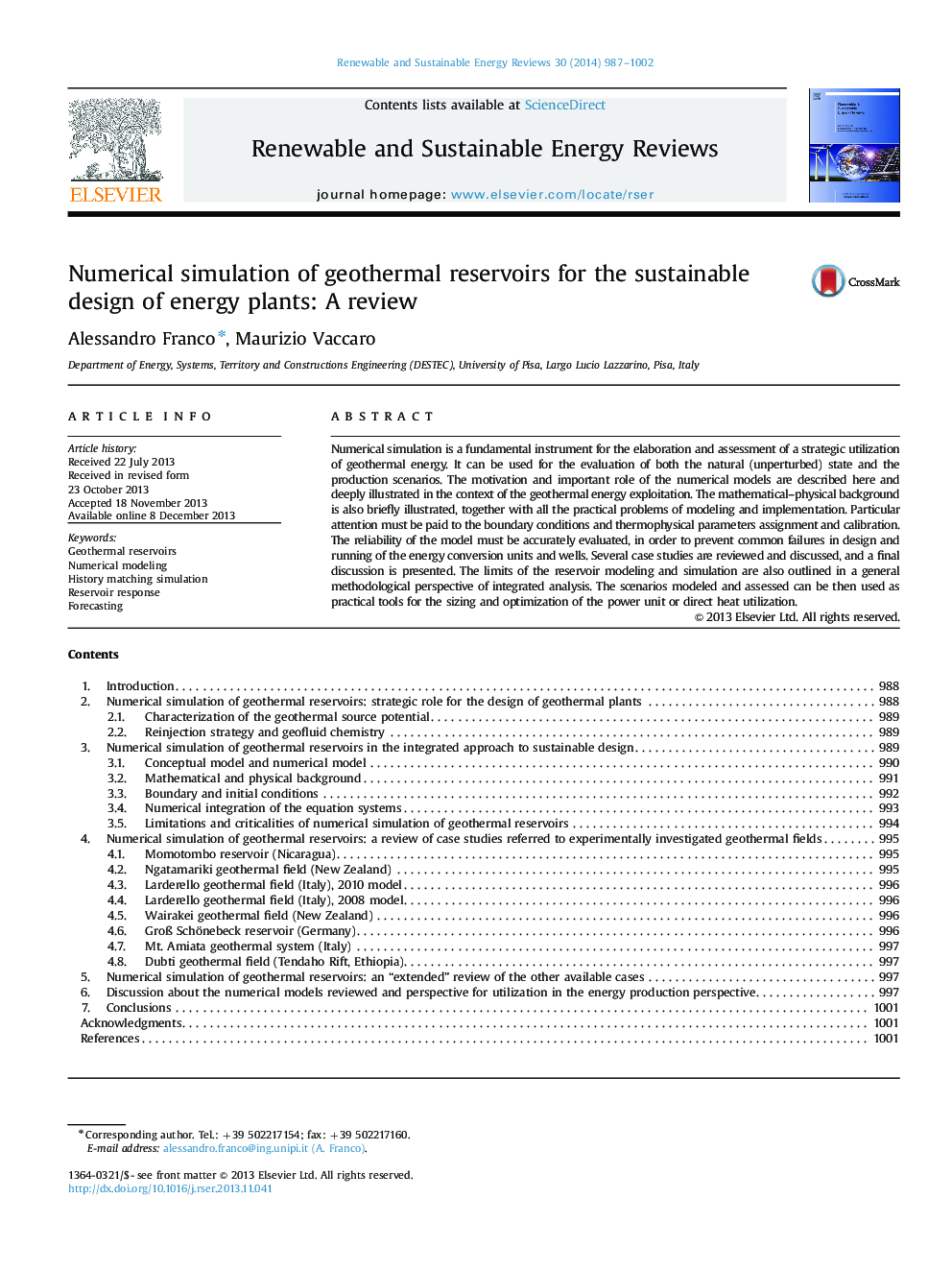| کد مقاله | کد نشریه | سال انتشار | مقاله انگلیسی | نسخه تمام متن |
|---|---|---|---|---|
| 8120860 | 1522355 | 2014 | 16 صفحه PDF | دانلود رایگان |
عنوان انگلیسی مقاله ISI
Numerical simulation of geothermal reservoirs for the sustainable design of energy plants: A review
ترجمه فارسی عنوان
شبیه سازی عددی مخازن زمین گرمایی برای طراحی پایدار انرژی گیاهان: یک بررسی
دانلود مقاله + سفارش ترجمه
دانلود مقاله ISI انگلیسی
رایگان برای ایرانیان
کلمات کلیدی
مخازن ژئوترمال، مدل سازی عددی، تاریخچه سازگاری شبیه سازی، پاسخ مخزن، پیش بینی،
ترجمه چکیده
شبیه سازی عددی یک ابزار اساسی برای توسعه و ارزیابی استفاده استراتژیک انرژی زمین گرمایی است. این می تواند برای ارزیابی هر دو حالت طبیعی (ناهموار) و سناریوهای تولید استفاده شود. انگیزه و نقش مهم مدل های عددی در اینجا شرح داده شده و عمیقا در زمینه استفاده از انرژی زمین گرمایی نشان داده شده است. پس زمینه ریاضی-فیزیکی نیز به طور خلاصه نشان داده شده است، همراه با تمام مشکلات عملی مدل سازی و پیاده سازی. توجه ویژه باید به شرایط مرزی و تخصیص و کالیبراسیون پارامترهای ترموفیزیک پرداخت شود. اطمینان از مدل باید با دقت بررسی شود، به منظور جلوگیری از شکست های معمول در طراحی و اجرای واحد های تبدیل انرژی و چاه ها. مطالعات موردی چند مورد بررسی و بحث می شود و یک بحث نهایی ارائه می شود. محدودیت های مدل سازی و شبیه سازی مخزن نیز در دیدگاه روش شناختی یکپارچه تحلیل می شود. سپس سناریوهای مدل سازی شده و ارزیابی می توانند بعنوان ابزار عملی برای اندازه گیری و بهینه سازی واحد قدرت یا استفاده مستقیم از گرما استفاده شوند.
موضوعات مرتبط
مهندسی و علوم پایه
مهندسی انرژی
انرژی های تجدید پذیر، توسعه پایدار و محیط زیست
چکیده انگلیسی
Numerical simulation is a fundamental instrument for the elaboration and assessment of a strategic utilization of geothermal energy. It can be used for the evaluation of both the natural (unperturbed) state and the production scenarios. The motivation and important role of the numerical models are described here and deeply illustrated in the context of the geothermal energy exploitation. The mathematical-physical background is also briefly illustrated, together with all the practical problems of modeling and implementation. Particular attention must be paid to the boundary conditions and thermophysical parameters assignment and calibration. The reliability of the model must be accurately evaluated, in order to prevent common failures in design and running of the energy conversion units and wells. Several case studies are reviewed and discussed, and a final discussion is presented. The limits of the reservoir modeling and simulation are also outlined in a general methodological perspective of integrated analysis. The scenarios modeled and assessed can be then used as practical tools for the sizing and optimization of the power unit or direct heat utilization.
ناشر
Database: Elsevier - ScienceDirect (ساینس دایرکت)
Journal: Renewable and Sustainable Energy Reviews - Volume 30, February 2014, Pages 987-1002
Journal: Renewable and Sustainable Energy Reviews - Volume 30, February 2014, Pages 987-1002
نویسندگان
Alessandro Franco, Maurizio Vaccaro,
